Ken Norwick is a systems analyst and an electric vehicle advocate who converted his 1996 Saturn to electric power two years ago.

Monday, 8 Jul 2002
CALGARY, Alberta, Canada
I’m a programmer by way of occupation, but a “Curious George” by nature. I like to spend my free time out in my garage tinkering away. For the next five days I am going to describe what it is like to live and commute with an electric car — specifically, with my somewhat weather-beaten 1996 Saturn four-door sedan that was given a new lease on life by way of a motor transplant.

Ken with the electric Saturn in winter.
A little over a year ago, I rescued this badly smoking car and transformed it into a battery-powered electric vehicle that produces no emissions whatsoever. I documented this conversion process in an online diary. In doing so, I became one of a growing group of electric vehicle enthusiasts around the world who could not or would not wait for the auto industry to produce a zero-emissions vehicle, and so took matters into their own hands.
At the turn of the last century, electric vehicles and petrol-powered automobiles were running neck-and-neck in popularity. By the early 1920s, increases in the availability of cheap gasoline coupled with the invention of the electric starter motor allowed vehicles powered by internal combustion engines to outpace the electric automobile. Electric vehicles soon disappeared from the motoring landscape.
Increased sensitivity to the problems of climate change and pollution brought the electric vehicle back into the public eye in the early 1970s, aided by advances in electric motors, electronic control systems, and battery storage cells. Engineering teams from the major automotive manufacturers were tasked with exploring new transportation alternatives. At the same time, a grassroots movement to build zero-emission vehicles began in the American southwest, and has been spreading up the West Coast and around the world.
My particular conversion project got its start late in 2000, so I have been driving my electric vehicle for over a year now. The Saturn has seen weather from -31 to 95 degrees Fahrenheit, and has survived blizzards that stopped many other cars and trucks in their tracks. It gets a daily recharge from one of two sources. The wall of my garage has a special plug dedicated to my Saturn, and I have been lucky enough to find sponsors to provide electricity as required at my place of work.
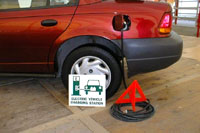
Charging the Saturn.
I’m also lucky to have a relatively short commute to work. I’d be hard-pressed to travel 15 miles in a day, so my energy requirements cannot be taken as the norm. Most people have a much longer journey to work and back, and the range restrictions of the current electric vehicles on the market are not suited to longer commutes. My electric vehicle is able to travel 40 to 75 miles on a single charge, but you can effectively double your range by charging at your destination. Emerging battery technologies will allow electric vehicles to travel 100 to 300 miles per charge. These new batteries will be much smaller and lighter than the batteries that I carry in the two racks in the rear of my car. I use the batteries out of a golf cart to give me the best possible range. The Saturn carries 18 of these 70-pound batteries, which adds about 1,300 pounds to the total weight of the car. That is a lot of lead to be hauling in a small car like the Saturn, and I had to help the poor little thing by modifying the rear suspension.
My Saturn is no way representative of the new breed of commercially available electric vehicles just coming on the market; rather, it’s typical of a homemade electric vehicle in that it is effectively a recycled gasoline-powered car. In its new life as an EV, it has no gasoline motor, no exhaust system, no gas tank, no radiator, and no fluids. It is quiet and emits nothing. Maintenance on an EV is much reduced, as there are very few moving parts. Mechanics hate them! No valves to adjust (or to burn out), no tune-ups, and no oil changes. The bearings in my car’s electric motor are sealed for life and will probably last 15 to 20 years. Of course, there are always parts such as brakes and tires that will need service, but generally speaking, maintenance costs on an electric vehicle are drastically lower than a typical gasoline-powered car.
Most private conversion projects begin with a discarded or expired gasoline-powered vehicle for the simple reason that it is a lot easier to get an EV up and running if you don’t have to build your car from scratch. The auto manufacturers put a lot of engineering into each car they make, and the costs would be prohibitive for an individual trying to duplicate the complex drive train, suspension, steering, and braking systems of the modern automobile. Besides, giving a worn-out car or truck a new lease on life as a non-polluting electric vehicle is noble example of recycling. The alternative for these vehicles would be a trip to the wreckers.
Still, a conversion project undertaken by a private individual can be quite costly, and one way to minimize any expenses is draw on the experience of fellow EV enthusiasts from all over the world. Like myself, many have set up web sites that fully describe their respective projects. My online diary contains more than 200 pages of information and hundreds of images. Visitors from 8 to 15 time zones per day drop in to this site for information.
In fact, this is generally how my day starts. Early each morning, I log onto my computer and go to my website to make sure that it is up and running. I go to the web stats page to get reports of the number of recent visitors, their locations, and the name of the organizations or schools that they belong to. My next EV-related task for the day is to open my emails from site visitors and to try to briefly answer any questions they have. My online diary generates a lot of interest, and is great to hear from people in Sweden, Japan, India, Turkey, Israel, Germany, England, or the good old U.S.A.
I’m always adding or changing things on the car, and each time I do, I try to make sure that my digital camera is close by. The images I take could be of the weirdest things, but you just never know what might be of interest to a person just starting their own conversion project. These pictures get added to the website, and I try to find the time to add commentary and informational links as well.
Maintenance of my site usually takes place in the evenings after I get home from work. I find it to be a time-consuming but necessary process; maintaining the conversion diary and keeping it current has become one of the most important of my EV-related tasks each day. Judging by the emails I receive, everyone else feels the same way. A constantly changing website keeps people returning for more information, and this is a very important aspect of the educational process.
Driving my Saturn EV for over a year has given me a newfound respect for the capabilities of electric vehicles. It is still very much a work in progress — a sort of rolling science experiment. I often get asked to present the car to science classes and at various locations around the city. I meet a lot of people while driving this car around town, and their general impression is that electric vehicles are slow and stodgy — just glorified golf carts. Let’s put that one to rest; this car is spunky to say the least. Its top speed is somewhere between 75 and 100 miles per hour, and I am never the one holding up traffic!
Speaking of which, it’s time to get to work, so I’ll be on my way to the garage to unplug the car and get the day started.
Tuesday, 9 Jul 2002
CALGARY, Alberta, Canada
I turn the key to the start position on my homemade 1996 Saturn electric car and hold it for about a second. The soft click that follows is the only indication that the car has started. I push the clutch in and shift into reverse. With your foot off of the accelerator pedal there is no need to use the clutch in the conventional way, as an electric motor does not idle like an internal combustion engine. It simply stops turning and waits for the driver’s next input from the “gas” pedal.
As soon as at least 10 amps of power starts to flow through the car’s power grid, the E-Meter on the top of the dash comes to life, reporting the vital signs to the driver. These meters (or their equivalent from another manufacturer) are an important component of any electric vehicle conversion. A small computer inside is wired into the power circuits of the car, and control signals sent to this unit are constantly monitored. I can use a small switch on the face of the instrument to select from the various reporting functions.
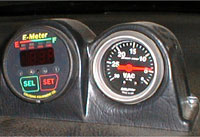
The Saturn’s E-Meter.
In car terms, you can think of the E-Meter as a fuel gauge, but it does a lot more than that. When I first built the car and installed the gauge, it had to be calibrated to this particular vehicle and its combination of system voltage, battery chemistry, and capacity. For example, this car uses 18 eight-volt batteries to store its energy for a total system voltage of 144 volts. The E-Meter knows this because I told it so when I first entered the system configuration into the computer. It also knows that these batteries have a storage capacity of 165 ampere-hours per battery. You might think of these as the functional equivalent of “gallons of gasoline.”
A small device known as a shunt is housed in a protective case under the hood. The E-Meter senses the current flow across this unit, and is able to derive your energy usage patterns while you are driving. From that information, it can calculate the approximate state of charge and total power consumed for your current trip. When I changed my battery pack last week, I had to re-program the computer with the new parameters so that it could accurately monitor and report on the state of the union under the hood.
When you begin driving an electric vehicle, and especially when you have the only one on the road in your state or province, you must develop a Zen-like awareness of its systems and their maintenance needs. This is especially true of home-built electric vehicles such as my Saturn. They are typically one-of-a-kind prototypes, and the builders such as myself are often the only person around that knows how they work. You become aware that there are no filling stations along your route that can help you if you need an energy fill up, and so you constantly watch your E-Meter and the units of power that you are consuming.
Given the limited range ( about 50 to 150 miles) of the current crop of electric vehicles, you put a lot of planning into all of your outings. For example, I know that there are two roads I can take up the large hill between my house and the University Research Park. One road is heavily traveled, while the other is not. By taking the less-traveled route, I am able to limit the current flowing to the motor by simply slowing down the car. Less current used translates to a longer range on the same charge. Planning your driving route in this manner uses a lot less energy, and by careful use of my rear view mirror I can make sure that this particular driving style is only used when it will not hold up the other drivers on the road. Heaven forbid that all of those people in their three-ton sport utility vehicles can’t make full use of that V8 in the residential neighborhoods!
You would be surprised how getting off of the main roads and using side streets can improve your commuting experience. You see a lot more, and the driving is more enjoyable. We all probably need to slow our lives down more often; an electric vehicle can help you do this.
My son Brian hurries out to the garage and into the car, and I am off to deliver him to a friend’s house before going to my office. Since completing this electric vehicle I have become very much a creature of habit. One of the rituals I undertake each morning without fail is to make sure that I reset the trip odometer to zero. That way I can track my exact distance from the plug in my garage to the plug that the research council has provided for me in their parking lot. It is really starting to get very silly, as I know the distance by heart now; it is precisely 5.4 km ( about 3.4 miles) one way. Maybe for some excitement I will stop for milk on the way home from work and the trip meter will register a new distance!
I often stop to think about how many of the details of each day’s commute I fuss over now. Ever since putting this homebuilt electric car on the road I spend a lot of time thinking about kilowatt-hours, volts, and amperes. I’ve had several batteries fail during various times this past year, and I have become acutely aware of this car’s needs.
Most people won’t want to get so involved with their cars, and when commercially available electric vehicles finally arrive in the showrooms, they’ll be as sophisticated and as easy to use as any of the modern gasoline-powered vehicles. They just won’t make any noise or emissions. Doesn’t sound too bad, does it?
Wednesday, 10 Jul 2002
CALGARY, Alberta, Canada
I was going to begin this diary by discussing what I call “topographical driving,” which involves planning a trip according to the obstacles you are likely to encounter, for the purpose of minimizing energy use. But the last two diary entries seem to have touched a nerve with a few readers out there, so for all of those interested parties, we’ll look at the politics of the electric vehicle.
Amy, a Grist reader from the Pacific Northwest, rightfully points out that although my vehicle produces no tailpipe emissions, the electricity used to power it may be produced by other than renewable sources. Coal-fired or natural gas powered plants have their own emissions to deal with. Driving a zero-emissions vehicle (ZEV) such as my battery-powered Saturn simply shifts the burden of pollution/emissions to another location.
And there the fight begins! Advocates on both sides of any issue can (and will) throw out statistics to support their point of view. As individuals, we can pick and choose from a myriad of products and services, each with their own kind of environmental impact. Most, if not all, human activities have some impact on the world we live in. The trick is to tread as lightly as you can during your relatively short stay on Earth. It is important to note that we are all in this together, and it is the sum of all of our activities that really matters.
Let’s get back to driving an electric vehicle and how this relates to power generation, so that we can shed some light on the issues. Shifting the burden is an important concept for residents of the Los Angeles basin, for example. Driving environmentally appropriate vehicles such as electric vehicles would drastically reduce the local air pollution at the point where people actually live. True, this is just an example of shifting the emissions, but consider the effects:
- Electric motors are two to three times as efficient as their internal combustion cousins. This means that more of each unit of energy is translated into useful motion, rather than into wasted heat and noise. After I race around town in my EV, the motor is barely warm to the touch. It only has a small internal fan blade mounted on the end of the output shaft for cooling. This tells me that the energy used to drive the vehicle down the road was used for just that, mostly, and not to produce more noise and heat pollution.
We know that environmental problems exist, that we are all contributors, and that something must be done — and done soon — to reverse the damage to our planet. My EV solves some problems, but creates others. (For example, an increase in electric vehicle use would bring the issue of spent battery pack recycling to the forefront.) Studying the issues and educating others is one way that we can all help out.
The issues are not black and white, but a mixture of grays. You can around in an old VW bus (even with a perfectly tuned motor) getting 45 miles per gallon and snubbing your environmental nose at the fellow in the 8-mpg SUV, but you may be the big negative on the balance sheet of life: It would probably take 10 to 20 of those sport utility vehicles with their advanced emissions controls to match the crap coming out of the VW’s tailpipe!
Have a nice day and be sure to visit my website and send your comments in an email. Judging by last night’s email response to the daily diary entry, I’m sure that if I’ve neglected to say something, I’ll be corrected tonight by all of the Grist readers out there!
Wednesday, 10 Jul 2002
CALGARY, Alberta, Canada
Planning for winter — it’s a weird thing to be thinking about at the beginning of the summer, but with my busy schedule I don’t really have a choice. I need to repair the electric heaters located under the dash of my EV car before the cold weather comes. The car survived a spell of -35 degree Fahrenheit temperatures this past winter, but one of the heater cores stopped working in the middle of a cold snap. I was glad that I had worn mittens that morning!
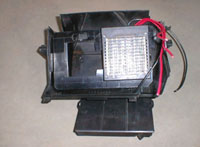
The heat isn’t on.
The heaters are a critical system in my car that will have to be fixed while I can still work out in the garage comfortably. Since an EV has no need for a radiator, you have to find other ways to heat the car’s interior. My Saturn EV employs twin electric heating elements that have been completely integrated with the original ducting under the dash. These ceramic elements can be thought of as big hair dryers that draw their power from the main battery packs. The range of your EV is significantly reduced in the winter months when these are turned on.
A lot of people have stopped to ask me questions about the car’s construction. They want to know what parts are required to build an EV and where one would find such items. All electric vehicles generally have the same categories of components. Most conversion projects begin with a small car or a light truck; unnecessary parts and systems are simply removed from the chassis. Obviously, the original gasoline engine is removed, but most often the transmission and drive shafts get to stay, as they are still needed by the electric drive components. Even though most electric motors have a broad power range, the original transmission acts to multiply the torque, and keeps the motor turning fast enough for the small fan inside to provide enough cooling at slower speeds. The fuel tank, pumps, and exhaust systems are stripped away, along with the radiator and its hoses. Your conversion project can start in earnest after you spray wash the grease and oil from under the hood. You really don’t need that stuff anymore!
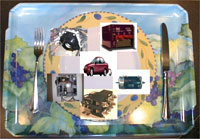
EV a la carte.
If I were in a restaurant ordering an “EV a la carte,” I would select the following:
- An electric motor. Take your pick from many varieties.
- A custom adapter plate to mate the motor to the original transmission housing.
- A motor controller known as a motor drive.
- An assortment of fuses, relays and a main power switch, known as a contactor.
- A set of batteries to store the electric energy needed by the vehicle.
- A set of racks or boxes to contain the batteries.
- A charger to “refill” the batteries as required.
- Lengths of heavy cable to interconnect the batteries and to bring power to the motor and its controller.
- A small computer known as an “E-Meter” to act as a fuel gauge
- And for dessert, I would request a handful of brackets topped off with some connectors and do-dads for holding everything together.
There you have it! A quiet, smog-free meal for two in a romantic setting where you can actually stop to smell the flowers without choking on the fumes of a stinking diesel engine.
Actually, I should mention that no EV meal is complete without a generous helping of manual labor. The cost of this “sweat equity” is hard to determine, as most EV enthusiasts undertake these conversion projects as labors of love.
For the majority of you out there concerned with pollution and climate change issues, one of the hybrid vehicles from Honda, Toyota, Ford, or another car company will probably make the most sense. The gasoline engines in these vehicles are ultra low-emission, and with their amazing fuel economies, they use far less fuel per mile of travel. Hybrid drive technology was designed to provide a “bridge” to the future. What the future looks like, of course, is anyone’s guess!
Friday, 12 Jul 2002
CALGARY, Alberta, Canada
Like anyone else on a Friday afternoon, I hope to leave work at a reasonable time. I will run past everyone I see, wishing them all a good weekend, and then I will head across the parking lot of the research park to my electric vehicle. Even the CEO of Calgary Technologies does not have a reserved spot in the parking lot for his SUV. But for a little red Saturn four-door, life is good.
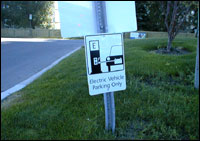
The Saturn’s parking spot.
Some mornings when we meet at the entrance to the parking lot I’m embarrassed to be pulling into a reserved spot with my electric vehicle while the head honcho searches for any free spot he can find, but the feeling quickly passes. Most parking spots in Calgary are equipped with electrical plugs on short poles for drivers to use in the winter for the block heaters of their cars, but this particular spot was upgraded to provide a 30 amp circuit for my Saturn’s charging needs.
Actually, now would be a good time to thank my corporate sponsors (Interstate Batteries, Calgary Technologies, and Mountain Equipment Co-Op) for all of their help and support. And thanks especially for the free electricity! I always have fun answering the question: “Just how much does it cost you to run this thing for a week?”
I’d also like to thank Grist for asking me to write these five days of diary entries about living and commuting with an EV, and for giving me a forum to share some of my ideas. Grist readers wanting to know more about recycling a car into an electric vehicle should check out my extensive conversion diary.
All over the world, people are researching future transportation alternatives. Altruism does not drive most of this work, but the net effect is the same. I think Europeans are generally more aware than North Americans of environmental issues, and are more willing to try new transportation technologies such as those used in electric vehicles. Many tourist areas in northern Italy have banned petroleum-powered vehicles altogether, and in London, a smog tax of £7 (about $10) is levied each day on every car or truck that comes into the city. But until people have reliable alternatives, they’ll continue using their conventional, polluting vehicles. That’s why my Saturn EV is so important to our beautiful city. It is a catalyst for conversation and a real thought-provoker, and you never know where such things will lead.
Calgary will probably be the last place on earth where electric vehicle use will rapidly rise in popularity. Around here, it’s hard for most people to take climate change seriously. The gorgeous vistas, crystal blue skies, and plentiful clean water and air do not help to transmit a sense of urgency to the average person. It is a stunningly beautiful place, and life for the majority is good here. We all have friends or relatives that live in other places and have to put up with polluted water and air each day, but a lot of us living in the wide-open spaces of the Rocky Mountain foothills have trouble comprehending any notion of impending climatic doom.
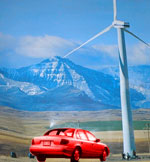
Rocky Mountain high times.
To be fair, there are many environmentally minded people around me who quietly go about trying to make life better for the rest of us. The Vestas windmill, for example, is one of many lining Cowley Ridge to the south of Calgary. The power produced by this wind farm is channeled back into the grid to power another type of electric vehicle — our city’s light rail transit, which consumes the majority of this green power. The engineering firm that manages these windmills has their offices just down the hall from my Internet software shop. It doesn’t matter whether your contribution is big or small, as long as you do your part.
As I drive — quietly — away from work in my battery-powered Saturn, I would like to leave you with a real Rocky Mountain High to remind you of why it is important that we all try to do something to help. This picture was taken at the head of a mountain pass just south of our city, and you can see why the late, great John Denver wrote a song with the same name. Take care, and spend some time with your families this weekend.


